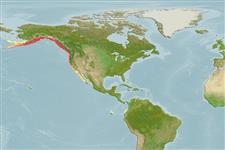Asteroidea |
Forcipulatida |
Asteriidae
Environment: milieu / climate zone / djupintervall / distribution range
Ekologi
; djupintervall 0 - 435 m (Ref. 865). Temperate
Eastern Pacific: Alaska to Mexico. IUCN status from Ref. 123434.
Length at first maturity / Size / Weight / Age
Könsmognad: Lm ? range ? - ? cm Max length : 90.0 cm WD hane/ej könsbestämd; (Ref. 865)
It is found on rocky and soft bottoms from the low intertidal to a depth of 435 meters (Ref. 865).
Life cycle and mating behavior
Könsmognad | Reproduktion | Lek | Eggs | Fecundity | Larvae
Members of the class Asteroidea exhibit both asexual (regeneration and clonal) and sexual (gonochoric) means of reproduction. Life cycle: Embryos hatch into planktonic larvae and later metamorphose into pentamorous juveniles which develop into young sea stars with stubby arms.
Lambert, P. 2000 Sea stars of British Columbia, Southeast Alaska and Puget Sound. Canada: UBC Press. 186 p. (Ref. 93256)
IUCN Red List Status
(Ref. 130435: Version 2025-1)
CITES status (Ref. 108899)
Not Evaluated
Not Evaluated
Threat to humans
Human uses
| FishSource |
Verktyg
Ytterligare information
Trophic EcologyFood items (preys)FödosammansättningFödointagPredatorer Population dynamicsTillväxt
Max. ages / sizes
Length-weight rel.
Length-length rel.
Length-frequencies
Mass conversion
Abundans
Human RelatedStamps, coins, misc.
Internet-källor
Estimates based on models
Preferred temperature
(Ref.
115969): 4.8 - 8.8, mean 6.3 (based on 185 cells).
Fishing Vulnerability
High vulnerability (56 of 100).
Price category
Unknown.
